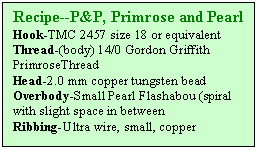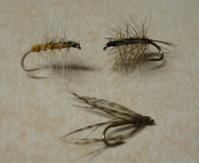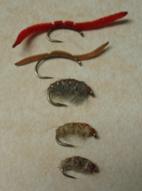What’s In Your Fly Box?
If you are coming to Branson to fly fish at Taneycomo (or any of the White River system), stock your fly box with these flies–olive soft hackles, olive wooly buggers, Primrose & Pearl, Burgundy Midge, and Copper Dun, cracklebacks in green holographic and pumpkin, San Juan worms in red and natural brown, and scuds in colors tan, gray, and orange flashback. You can call them "hot" flies, "go to" flies, or "guide" flies, because on any day one of these flies is going to catch trout in this Missouri tail water.
 |
| Zebra Midges |
At RRO, we fish our local variations of the zebra midge–the P&P (primrose and pearl), the BM (burgundy midge), and the Copper Dun every day. The P&P was developed by our fly shop manager Shannon to match a hatch that was photographed by a local fly fisherman. The pattern works most consistently on sunny days, but the fish in their own quirky fashion will hit it almost any time. The P&P is proving itself in Arkansas waters and even out west where Stan fished it on Wyoming’s North Platte. The BM is the newest addition to the midge lineup, and if you pack it along with the old faithful Copper Dun (another one of Shannon’s creations) and tie on one of these first thing in the morning, you come as close to a guaranteed catch as we can make. Typically, the midges are fished on 6x fluorocarbon tippet under an indicator at depths from six inches to six feet, depending on where the fish are holding. Look for seams of moving water and maintain a dead drift so that the fly hangs in a vertical position from the indicator. Keep the fly line mended! In swifter water, put on a split shot about eight to twelve inches above the fly. By the way, we tie all three of these midges in size 18.

While we are talking midges, Carolyn’s favorite pastime is stripping a size 18 dark olive soft hackle when the trout are rising to the surface to feed on a midge hatch. Cast at three quarters across the current and let the fly swing downstream. Vary the strips until you find a rhythm the trout want to dance to. Use fine tippet, 5X or 6X, and no indicator-you get to feel the strike. When soft hackles are working, fly fishing just doesn’t get any better!
 |
| Cracklebacks |
Cracklebacks can be fished in a manner similar to the soft hackle or even a little like a dry fly. In the warm buggy months cast it into the bank and let it float or pull it under and strip it back. RRO’s favorite cracklebacks are size 14 and 16 green holographic and pumpkin.
 |
| Favorites in the outlets below Shepherd of the Hills Hatchery |
The outlets below Shepherd of the Hills Hatchery are a favorite fishing spot because of the easy wading access and numbers of trout that line up in the out flow. Scuds are most successful here and anywhere there is a good riffle on the water. The most consistent choices are tan and gray in sizes 14 to 20. RRO’s guide Jim Lund created the orange flashback scud. Jim will tie it on with a blood worm dropper; the trout will take the scud, or the scud will act as an attractor and the trout will take the blood worm. The San Juan worm will work here too, alone or as a dropper. If the horn blows to signal a water release below the dam, definitely tie on a San Juan with some split shot and fish the rise along the banks. As a rule of thumb for fishing these flies, use an indicator and set the depth at one and a half times the depth of the water. Get that fly on the bottom and keep the line mended for a good dead drift. When you see that indicator do anything– go under or hesitate, set the hook! Don’t assume you are dragging the bottom. Bottom or fish-think fish!
 |
| The Wooly Bugger |
No fly box would be complete without a wooly bugger. At Taneycomo the bugger tied in size 10 with olive marabou is the most consistent streamer pattern. Some die hard fly fishers exclusively strip woolies across the riffles, along the bottom in downstream presentations, or swing them across the current in to seams. The odds for pulling up a hefty rainbow or brown might go up with this method, and you might want to bring along a sink tip for fishing the deeper or swifter waters. Nothing beats feeling a strong fish hook up on a wooly bugger.
On any day, it is a good idea to stop by RRO and ask what fly is working. We have guides on the water most days and regular customers who keep us informed. We want you to have a good day at Taneycomo and catch fish. A fly box filled with RRO’s favorites is for sale at the shop, or if you want to tie your own, we have the materials. Check our online store. The recipes for the midges are on this web site.
River Run Outfitters – Everything for the Fly Fisher
Orvis Endorsed Guide Service
Rentals for Waders and Fly Rod & Reel
Fly Fishing and Fly Tying Classes
Missouri Fishing Permits, annual and daily






